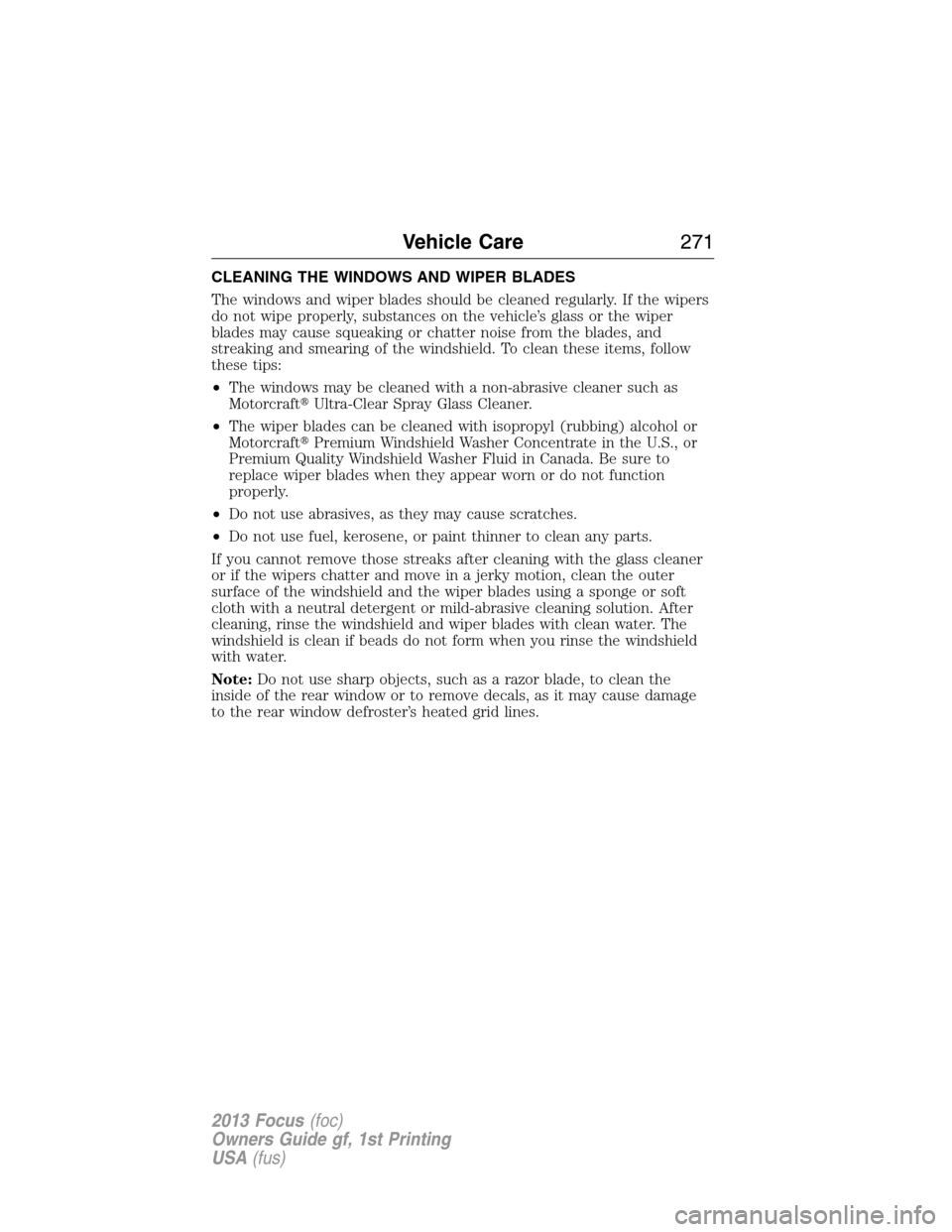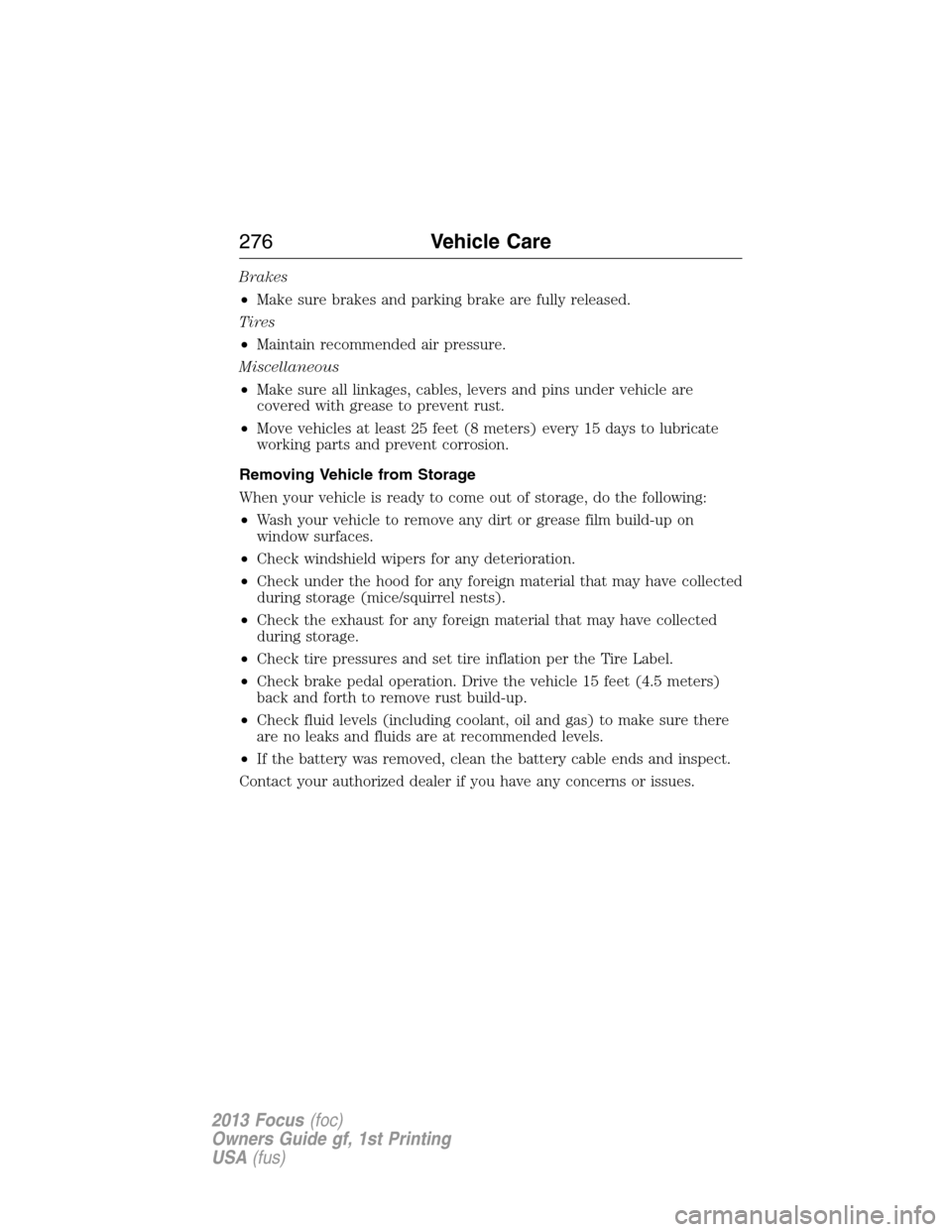Page 167 of 475

3. Start the engine. The engine may continue cranking for up to
15 seconds or until it starts.
Note:If you cannot start your engine on the first try, wait for a short
period of time and try again.
If you have difficulty starting the engine when the temperature is below
-13°F (-25°C), press the accelerator pedal slightly and try again.
If you cannot start your engine after three attempts, wait 10 seconds,
then follow this procedure:
1. Fully press the brake pedal.
2. Fully press the accelerator pedal and hold it there.
3. Move the transmission selector lever to positionPorN.
4. Start the engine.
Guarding Against Exhaust Fumes
WARNING:If you smell exhaust fumes inside your vehicle, have
this checked immediately. Do not drive your vehicle if you smell
exhaust fumes. Carbon monoxide is present in exhaust fumes. Take
precautions to avoid its dangerous effects.
Important Ventilating Information
If you stop your vehicle and leave the engine idling for long periods of
time, we recommend that you do one of the following:
•Open the windows at least 1 inch (2.5 centimeters).
•Set your climate control to outside air.
ENGINE BLOCK HEATER (IF EQUIPPED)
WARNING:Failure to follow engine block heater instructions
could result in property damage or physical injury.
WARNING:Do not use your heater with ungrounded electrical
systems or two-pronged (cheater) adapters. There is a risk of
electrical shock.
Note:The heater is most effective when outdoor temperatures are below
0°F (-18°C).
Starting and Stopping the Engine167
2013 Focus(foc)
Owners Guide gf, 1st Printing
USA(fus)
Page 219 of 475

BREAKING-IN
You need to break in new tires for approximately 300 miles
(480 kilometers). During this time, your vehicle may exhibit some unique
driving characteristics. Avoid driving too fast during the first 1000 miles
(1600 kilometers). Vary your speed frequently and change up through
the gears early. Do not labor the engine. Do not tow during the first
1000 miles (1600 kilometers).
ECONOMICAL DRIVING
Fuel economy is affected by several things such as how you drive, the
conditions you drive under and how you maintain your vehicle.
There are some things to keep in mind that may improve your fuel
economy:
•Accelerate and slow down in a smooth, moderate fashion.
•Drive at steady speeds without stopping.
•Anticipate stops; slowing down may eliminate the need to stop.
•Combine errands and minimize stop-and-go driving.
•Close the windows for high-speed driving.
•Drive at reasonable speeds (traveling at 55 mph [88 km/h] uses 15%
less fuel than traveling at 65 mph [105 km/h]).
•Keep the tires properly inflated and use only the recommended size.
•Use the recommended engine oil.
•Perform all regularly scheduled maintenance.
There are also some things you may not want to do because they may
reduce your fuel economy:
•Sudden or hard accelerations.
•Rev the engine before turning it off.
•Idle for periods longer than one minute.
•Warm up your vehicle on cold mornings.
•Use the air conditioner or front defroster.
•Use the speed control in hilly terrain.
•Rest your foot on the brake pedal while driving.
•Drive a heavily loaded vehicle or tow a trailer.
Driving Hints219
2013 Focus(foc)
Owners Guide gf, 1st Printing
USA(fus)
Page 238 of 475
Fuse/Relay
NumberFuse Amp
RatingProtected Components
F3 — Not used
F4 — Not used
F5 — Not used
F6 — Not used
F7 40A** Anti-lock brake system/Electronic
stability program pump
F8 30A** Electronic stability program valve
F9 30A** Heated rear window
F10 40A** Heater blower motor
F11 — Not used
F12 30A** Engine control relay Fuse
F13 30A** Starter relay
F14 25A** Rear power window (without door
control unit)
F15 25A** Automatic transmission
F16 — Not used
F17 — Not used
F18 20A** Front wiper motor
F19 5A* Anti-lock brake system/Electronic
stability program 15 feed
F20 15A* Horn
F21 5A* Stop light switch
F22 15A* Battery monitor system
F23 5A* Relay coils, Light switch module
F24 — Not used
F25 10A* Power exterior mirror (without door
control unit)
F26 15A* Transmission control module 30 feed
automatic transmission
F27 15A* Air conditioning clutch
F28 5A* Mass air flow fuel relay feed
F29 20A* Not used (spare)
238Fuses
2013 Focus(foc)
Owners Guide gf, 1st Printing
USA(fus)
Page 239 of 475
Fuse/Relay
NumberFuse Amp
RatingProtected Components
F30 — Not used
F31 — Not used
F32 10A* Exhaust gas recovery valve, Swirl
control valves, Heated oxygen sensors
F33 15A* Ignition coils
F34 10A* Injectors
F35 5A* Active grill shutter
F36 10A* Engine control module
F37 — Not used
F38 15A* Engine control module/Transmission
control module 15 feed
F39 5A* Headlamp control module (Focus ST)
F40 5A* Electronic power assist steering 15
feed
F41 20A* Body control module 15 feed
F42 15A* Rear Wiper
F43 15A* HID headlamp leveling (Focus ST)
F44 — Not used
F45 — Not used
F46 25A* Power windows front (without door
control unit)
F47 7.5A* Heated mirror (without door control
unit)
F48 5A* Power exterior mirror (without door
control unit)
R1 — Not used
R2 Micro relay Horn
R3 — Not used
R4 — Not used
R5 Micro relay Rear wiper
R6 — Not used
R7 — Not used
Fuses239
2013 Focus(foc)
Owners Guide gf, 1st Printing
USA(fus)
Page 240 of 475
Fuse/Relay
NumberFuse Amp
RatingProtected Components
R8 — Not used
R9 — Not used
R10 Mini relay Starter relay
R11 Micro relay Air conditioning clutch
R12 Power relay Cooling fan
R13 Mini relay Heater blower
R14 Mini relay Engine control relay
R15 Power relay Heated rear window
R16 Power relay Ignition 15
*Mini Fuses **Cartridge Fuses
Passenger Compartment Fuse Panel
The fuse panel is located on the right side below the glove box.
56
57
58
59
60
61
62
63
6465
66
67
68
69
70
71
72
73
74
75
76
77
78
79
80
81
88
89
82
83
84
85
86
87
240Fuses
2013 Focus(foc)
Owners Guide gf, 1st Printing
USA(fus)
Page 258 of 475

Changing the Rear Window Wiper Blade (If Equipped)
To replace the rear wiper blade:
1. Press the wiper blade against the
glass with one hand and hold it.
2. Pull the wiper arm away from the
wiper blade to separate.
3. To attach the new wiper to the
wiper arm, align the slot (1) and
cross pin (2) and firmly press the
wiper arm into the wiper blade until
a click is heard.
If you find this procedure too difficult, please see your dealer.
AIR FILTER CHECK
WARNING:To reduce the risk of vehicle damage and/or personal
burn injuries do not start your engine with the air cleaner
removed and do not remove it while the engine is running.
When changing the air filter element, use only the air filter element
listed. Refer toMotorcraft�Part Numbersin the Capacities and
Specifications chapter.
For EcoBoost equipped vehicles: When servicing the air cleaner, it is
important that no foreign material enter the air induction system. The
engine and turbocharger are susceptible to damage from even small
particles.
Refer toScheduled Maintenancefor the appropriate intervals for
changing the air filter element.
Note:Failure to use the correct air filter element may result in severe
engine damage. The customer warranty may be void for any damage to
the engine if the correct air filter element is not used.
2
1
258Maintenance
2013 Focus(foc)
Owners Guide gf, 1st Printing
USA(fus)
Page 271 of 475

CLEANING THE WINDOWS AND WIPER BLADES
The windows and wiper blades should be cleaned regularly. If the wipers
do not wipe properly, substances on the vehicle’s glass or the wiper
blades may cause squeaking or chatter noise from the blades, and
streaking and smearing of the windshield. To clean these items, follow
these tips:
•The windows may be cleaned with a non-abrasive cleaner such as
Motorcraft�Ultra-Clear Spray Glass Cleaner.
•The wiper blades can be cleaned with isopropyl (rubbing) alcohol or
Motorcraft�Premium Windshield Washer Concentrate in the U.S., or
Premium Quality Windshield Washer Fluid in Canada. Be sure to
replace wiper blades when they appear worn or do not function
properly.
•Do not use abrasives, as they may cause scratches.
•Do not use fuel, kerosene, or paint thinner to clean any parts.
If you cannot remove those streaks after cleaning with the glass cleaner
or if the wipers chatter and move in a jerky motion, clean the outer
surface of the windshield and the wiper blades using a sponge or soft
cloth with a neutral detergent or mild-abrasive cleaning solution. After
cleaning, rinse the windshield and wiper blades with clean water. The
windshield is clean if beads do not form when you rinse the windshield
with water.
Note:Do not use sharp objects, such as a razor blade, to clean the
inside of the rear window or to remove decals, as it may cause damage
to the rear window defroster’s heated grid lines.
Vehicle Care271
2013 Focus(foc)
Owners Guide gf, 1st Printing
USA(fus)
Page 276 of 475

Brakes
•Make sure brakes and parking brake are fully released.
Tires
•Maintain recommended air pressure.
Miscellaneous
•Make sure all linkages, cables, levers and pins under vehicle are
covered with grease to prevent rust.
•Move vehicles at least 25 feet (8 meters) every 15 days to lubricate
working parts and prevent corrosion.
Removing Vehicle from Storage
When your vehicle is ready to come out of storage, do the following:
•Wash your vehicle to remove any dirt or grease film build-up on
window surfaces.
•Check windshield wipers for any deterioration.
•Check under the hood for any foreign material that may have collected
during storage (mice/squirrel nests).
•Check the exhaust for any foreign material that may have collected
during storage.
•Check tire pressures and set tire inflation per the Tire Label.
•Check brake pedal operation. Drive the vehicle 15 feet (4.5 meters)
back and forth to remove rust build-up.
•Check fluid levels (including coolant, oil and gas) to make sure there
are no leaks and fluids are at recommended levels.
•If the battery was removed, clean the battery cable ends and inspect.
Contact your authorized dealer if you have any concerns or issues.
276Vehicle Care
2013 Focus(foc)
Owners Guide gf, 1st Printing
USA(fus)